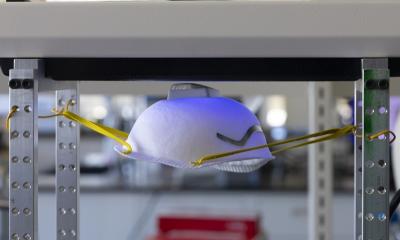Image credit: University of Southampton
News • Ultraviolet disinfection
Scientists discover how UV light destroys the coronavirus
New research has revealed how light can be used to destroy infectious coronavirus particles that contaminate surfaces.
Scientists are interested in how environments, such as surgeries, can be thoroughly disinfected from viruses such as Sars-CoV-2 that caused the Covid-19 pandemic. Sars-CoV-2 viral particles are composed of a core of nucleic acid chains that contain the genetic information of the virus, surrounded by a lipid membrane with proteinous spikes sticking out. Each component is necessary for infection.
Researchers from the University of Southampton investigated how ultraviolet laser light destroys the virus by impacting each of these critical components. By using a specialised ultraviolet laser at two different wavelengths the scientists were able to determine how each viral component degraded under the bright light. They found the genomic material was highly sensitive to degradation and protein spikes lost their ability to bind to human cells.
Light deactivation of airborne viruses offers a versatile tool for disinfection of our public spaces and sensitive equipment that may otherwise prove difficult to decontaminate with conventional methods
Sumeet Mahajan
UV light includes UVA, UVB and UVC light. Very little UVC light at frequencies below 280nm reaches the earth’s surface from the sun. It is this lesser studied UVC light that the team in Southampton used for their study due to its disinfectant properties. UVC light is strongly absorbed by different viral components, including the genetic material (~260nm) and the proteinous spikes (~230nm), allowing the team to select laser frequencies of 266nm and 227nm for the project.
University of Southampton scientists, led by Professor Sumeet Mahajan, worked closely with scientists from the laser manufacturer M Squared Lasers. The team found that 266nm light caused RNA damage at low powers, affecting the genetic information of the virus. 266nm light also damaged the structure of the Sars-CoV-2 spike protein, reducing its ability to bind to human cells by breaking down disulphide bonds and aromatic amino acids. The 227nm light was less effective at inducing RNA damage, but more effective at damaging proteins through oxidation (a chemical reaction involving oxygen) which unfolds the protein’s structure.
Importantly, Sars-CoV-2 has among the largest of genomes for RNA viruses. This makes it especially sensitive to genomic damage. Professor Mahajan said: “Light deactivation of airborne viruses offers a versatile tool for disinfection of our public spaces and sensitive equipment that may otherwise prove difficult to decontaminate with conventional methods. Now we understand the differential sensitivity of molecular components in viruses to light deactivation this opens up the possibility of a finely tuned disinfection technology.”
Light-based deactivation has received a lot of attention because of the wide range of applications where conventional liquid-based deactivation methods aren’t suitable. Now the mechanism of deactivation is better understood this is an important step in rolling out the technology.
Source: University of Southampton
11.01.2024











